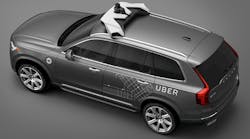Uber Technologies Inc. agreed to buy 24,000 sport utility vehicles from Sweden’s Volvo Cars to form a fleet of driverless autos.
The XC90s, priced from $46,900 at U.S. dealers, will be delivered between 2019 and 2021 in the first commercial purchase by a ride-hailing provider, Volvo said in a statement on Monday. San Francisco-based Uber will add its own sensors and software to permit pilot-less driving.
Uber’s order steps up efforts to replace human drivers, the biggest cost in its on-demand taxi service. The company has agreed to use 100 XC90s for self-driving tests in Pittsburgh, while also striking a deal to include autonomous vehicles from Daimler AG’s Mercedes-Benz in its network at some point.
“This new agreement puts us on a path toward mass-produced, self-driving vehicles at scale,” Jeff Miller, Uber’s head of auto alliances, told Bloomberg News. “The more people working on the problem, we’ll get there faster and with better, safer, more reliable systems.”
For carmakers, news of Uber buying vehicles at a commercial level means potential new sales, but also looming disruption to a business model that sees autos largely sold to private owners. Uber’s $70 billion valuation already puts the group almost on a par with Germany’s Daimler.
The deal will boost sales at Volvo and should also help lower the cost of the Chinese-controlled group’s own fully-autonomous cars planned from 2021. Volvo engineers have been working closely with Uber to develop a base vehicle with core driverless technology that the ride-hailing company can then augment. Volvo plans to use those cars for its own future offering.
“The automotive industry is being disrupted by technology and Volvo Cars chooses to be an active part of that disruption,” CEO Hakan Samuelsson said. “It’s a new market that’s emerging and we’re the first to be delivering into that segment.”
Uber, which didn’t put a timescale on when it might introduce driverless rides, said its approach means anyone in the industry can “deploy its tech.” It highlighted people using hand signals and eye contact to negotiate traffic as one of the major challenges remaining for autonomous autos.
By Elisabeth Behrmann



